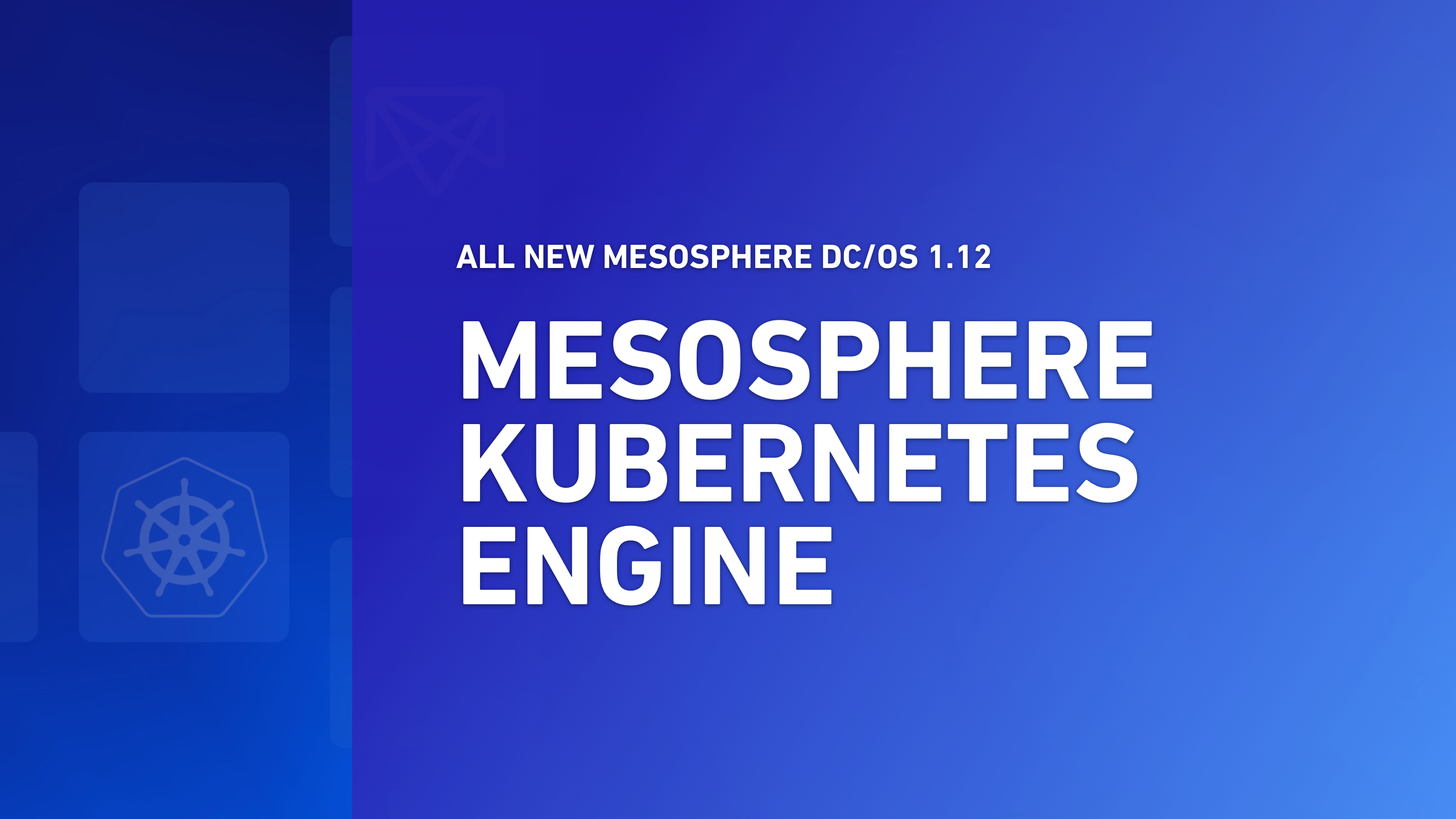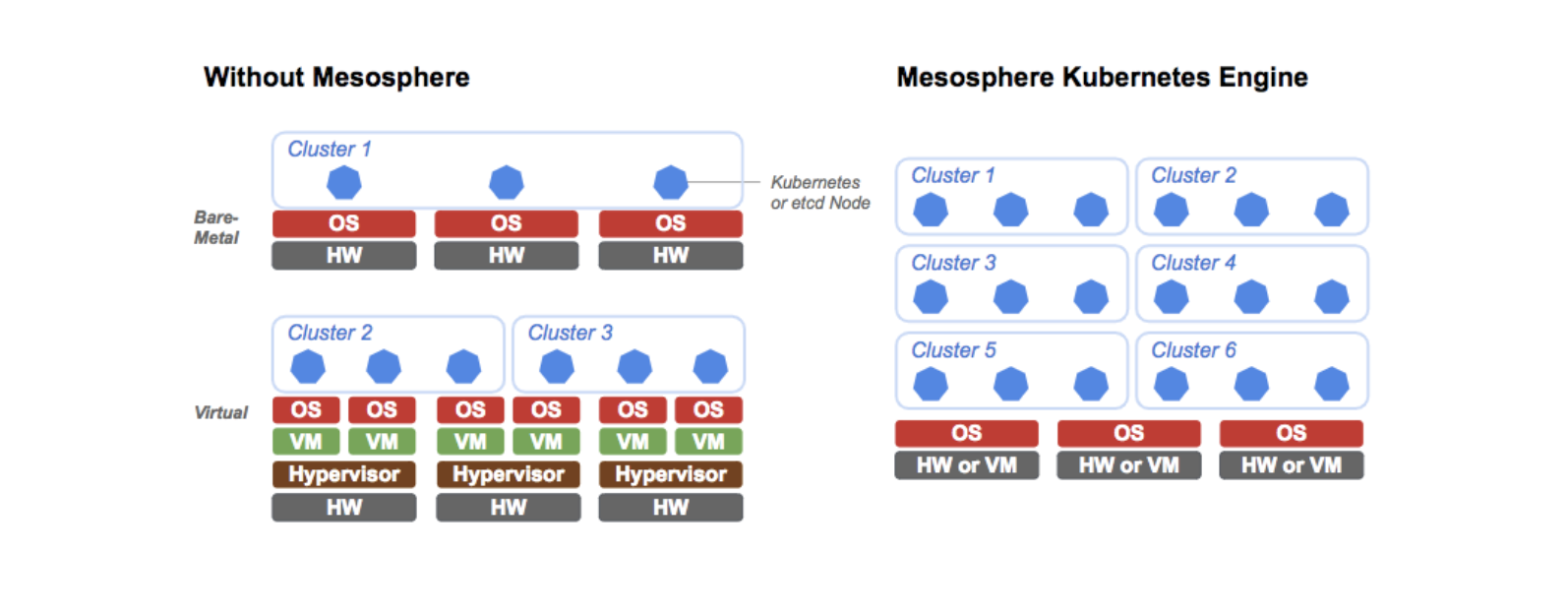Orchestrating Kubernetes Infrastructure on Bare Metal Servers, Virtualized Environments and the Edge Anywhere

While Kubernetes is the tool of choice for container orchestration, IT operations is facing many request from lines of businesses on implementing and managing Kubernetes. The struggle for these IT professionals is that managing multiple Kubernetes clusters requires a big time and resource investment, especially when there is an increased demand from internal teams that is leading to cluster sprawl. And if you're an enterprise company that has a large portfolio of apps, you need a solution that can enable you to run Kubernetes anywhere.
Mesosphere Kubernetes Engine (MKE) provides IT organizations with a centralized self-service control plane for managing multiple Kubernetes clusters. MKE features pure upstream Kubernetes, the market standard and most popular way to deploy Kubernetes among developer teams. MKE allows IT to centralize scattered and sprawling Kubernetes clusters on a bare-metal, virtualized, or public cloud infrastructure, so you can reduce operational overhead, tighten security controls, and cut infrastructure costs.
MKE includes a feature we are calling High Density Multi-Kubernetes (HDMK) which allows users to host multiple Kubernetes nodes on the same bare metal servers, virtual machines, or public cloud instances. This architecture can provide 50% saving on infrastructure and license cost compared to up the traditional way of running Kubernetes, with more saving as the scale or number of Kubernetes clusters grow.
Kubernetes Growth at Mesosphere
According to our latest Cloud Ecosystem report, the average user runs three or more services on Mesosphere, with some users running 11 different services on the same cluster. The fastest growing and most popular framework run by Mesosphere users is Kubernetes, which has shot to the top spot over the past year. Below is a snapshot of the volume of ecosystem workloads launched on Mesosphere.

Since March, there has been 12 releases of Kubernetes package at Mesosphere. That includes evergreen Kubernetes versions that have followed a similar cadence to the new versions available in the public clouds. The first release of MKE features Kubernetes 1.12, which was released by the community only a few weeks ago. We have adopted a number of customer requested features in our monthly releases including RBAC and authentication, CIS benchmarking tool, ability to run in strict mode and a locking down of the insecure API server ports.
High Density Multi-Kubernetes (HDMK)
Using High Density Multi-Kubernetes, MKE consolidates and bin packs multiple Kubernetes infrastructure components, with secure isolation, onto a single operating system instance regardless if it is on bare-metal, virtual or cloud environments. The traditional architecture of deploying a single Kubernetes node on a single virtual machines or server leads to sprawling licensing and infrastructure cost. With HDMK, operations pools compute resources that any Kubernetes node can then take advantage of. The result is increased agility for administrators, reduced infrastructure footprint and lower costs.
According to a Kubernetes survey by SIG UI, 84% of Kubernetes clusters are under 25 nodes. During our scale testing, engineers deployed 20 Kubernetes clusters with 30 nodes each, a total of 600 nodes, on 100 nodes of DC/OS. They also tested failure scenarios included killing all three Kubernetes control plane nodes. All three components healed as expected.

Kubernetes Network Isolation
MKE provides a policy driven, secure network by provisioning and configuring Calico for each Kubernetes cluster. Calico provides a simplified SDN that provides MKE with the network isolation between each instance of Kubernetes on the platform. Kubernetes users can now get access to a number of Calico features including Kubernetes network policies which allow organizations to define the policies that control pods communication on the cluster.
Lifecycle Automation
For application teams, MKE provides the ability to deploy Kubernetes clusters and configure its properties such as size and version according to their needs. Every Kubernetes cluster has an independent lifecycle in terms of deployment, scaling and upgrade. For Operators, MKE provides a centralized control plane to provide visibility and ensures leading practices such as High Availability, Self healing, Performance and Security are applied across the organization without sacrificing velocity.
Whether you're an existing Mesosphere customer or a new user, it's easy to get started using Mesosphere Kubernetes Engine (MKE) on DC/OS today. Click here to sign up for a demo.









